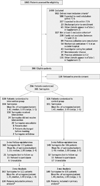Effect of Palliative Care-Led Meetings for Families of Patients With Chronic Critical Illness: A Randomized Clinical Trial
- PMID: 27380343
- PMCID: PMC5538801
- DOI: 10.1001/jama.2016.8474
Effect of Palliative Care-Led Meetings for Families of Patients With Chronic Critical Illness: A Randomized Clinical Trial
Erratum in
-
Percentage Error in Article.JAMA. 2017 May 23;317(20):2134. doi: 10.1001/jama.2017.4298. JAMA. 2017. PMID: 28535211 No abstract available.
Abstract
Importance: Family caregivers of patients with chronic critical illness experience significant psychological distress.
Objective: To determine whether family informational and emotional support meetings led by palliative care clinicians improve family anxiety and depression.
Design, setting, and participants: A multicenter randomized clinical trial conducted from October 2010 through November 2014 in 4 medical intensive care units (ICUs). Adult patients (aged ≥21 years) requiring 7 days of mechanical ventilation were randomized and their family surrogate decision makers were enrolled in the study. Observers were blinded to group allocation for the measurement of the primary outcomes.
Interventions: At least 2 structured family meetings led by palliative care specialists and provision of an informational brochure (intervention) compared with provision of an informational brochure and routine family meetings conducted by ICU teams (control). There were 130 patients with 184 family surrogate decision makers in the intervention group and 126 patients with 181 family surrogate decision makers in the control group.
Main outcomes and measures: The primary outcome was Hospital Anxiety and Depression Scale symptom score (HADS; score range, 0 [best] to 42 [worst]; minimal clinically important difference, 1.5) obtained during 3-month follow-up interviews with the surrogate decision makers. Secondary outcomes included posttraumatic stress disorder experienced by the family and measured by the Impact of Events Scale-Revised (IES-R; total score range, 0 [best] to 88 [worst]), discussion of patient preferences, hospital length of stay, and 90-day survival.
Results: Among 365 family surrogate decision makers (mean age, 51 years; 71% female), 312 completed the study. At 3 months, there was no significant difference in anxiety and depression symptoms between surrogate decision makers in the intervention group and the control group (adjusted mean HADS score, 12.2 vs 11.4, respectively; between-group difference, 0.8 [95% CI, -0.9 to 2.6]; P = .34). Posttraumatic stress disorder symptoms were higher in the intervention group (adjusted mean IES-R score, 25.9) compared with the control group (adjusted mean IES-R score, 21.3) (between-group difference, 4.60 [95% CI, 0.01 to 9.10]; P = .0495). There was no difference between groups regarding the discussion of patient preferences (intervention, 75%; control, 83%; odds ratio, 0.63 [95% CI, 0.34 to 1.16; P = .14]). The median number of hospital days for patients in the intervention vs the control group (19 days vs 23 days, respectively; between-group difference, -4 days [95% CI, -6 to 3 days]; P = .51) and 90-day survival (hazard ratio, 0.95 [95% CI, 0.65 to 1.38], P = .96) were not significantly different.
Conclusions and relevance: Among families of patients with chronic critical illness, the use of palliative care-led informational and emotional support meetings compared with usual care did not reduce anxiety or depression symptoms and may have increased posttraumatic stress disorder symptoms. These findings do not support routine or mandatory palliative care-led discussion of goals of care for all families of patients with chronic critical illness.
Trial registration: clinicaltrials.gov Identifier: NCT01230099.
Conflict of interest statement
Figures


Comment in
-
Strategies to Support Surrogate Decision Makers of Patients With Chronic Critical Illness: The Search Continues.JAMA. 2016 Jul 5;316(1):35-7. doi: 10.1001/jama.2016.8691. JAMA. 2016. PMID: 27380340 No abstract available.
-
Palliative Care-Led Meetings for Families of ICU Patients.JAMA. 2016 Oct 18;316(15):1597-1598. doi: 10.1001/jama.2016.14316. JAMA. 2016. PMID: 27755629 No abstract available.
-
Palliative Care-Led Meetings for Families of ICU Patients.JAMA. 2016 Oct 18;316(15):1598. doi: 10.1001/jama.2016.14319. JAMA. 2016. PMID: 27755630 No abstract available.
References
-
- Hough CL, Caldwell ES, Cox CE. ProVent Investigators and the National Heart Lung and Blood Institute’s Acute Respiratory Distress Syndrome Network. Development and validation of a mortality prediction model for patients receiving 14 days of mechanical ventilation. Crit Care Med. 2015;43(11):2339–2345. - PMC - PubMed
-
- Cameron JI, Chu LM, Matte A, et al. RECOVER Program Investigators (Phase 1: towards RECOVER) Canadian Critical Care Trials Group. One-year outcomes in caregivers of critically ill patients. N Engl J Med. 2016;374(19):1831–1841. - PubMed
Publication types
MeSH terms
Associated data
Grants and funding
LinkOut - more resources
Full Text Sources
Other Literature Sources
Medical

